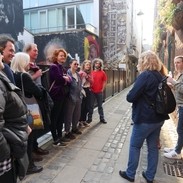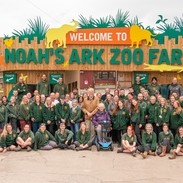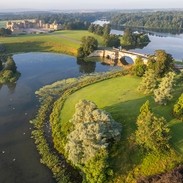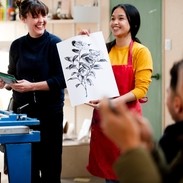Section 1: What is accessibility?
Photo by: VisitBritain/Pawel Libera
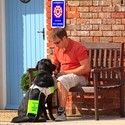
Top Tips
Accessibility involves removing barriers to provide positive experiences for all. In the case of this toolkit, it’s about ensuring that everyone can enjoy tourism.
Accessibility is one part of a wider Equality, Diversity and Inclusion topic.
Use the practical action checklists, technical design guidance and persona deck to help you move forward.
What is accessible tourism?
Equality, Diversity and Inclusion (EDI) is a topic being addressed by an increasing number of businesses. In summary, the term ‘equality’ relates to ensuring that everyone can access the same opportunities, ‘diversity’ means valuing the differences between people and their identifying characteristics, and ‘inclusion’ is a measure of how safe and welcome people feel in their environment. These are important, big-picture concepts that accessibility is embedded into.
Simply put, accessibility is all about removing barriers (whether physical, digital, relating to information and content, or attitudinal) to promote positive and equal experiences for all. It is the ‘actionable’ part of ensuring that EDI is on the agenda for disabled people in particular, but can also provide great benefit to customers and colleagues who might identify differently.
For example, providing audio tours and large print versions of exhibit information at museums are a great way of removing content barriers for people who are blind or partially sighted. Ensuring staff are well trained and equipping them with useful resources can really aid the removal of attitudinal barriers for disabled people as well as those with other protected characteristics related to age, race, and sexual orientation. Similarly, making an entrance more accessible to a wheelchair user is likely to involve the provision of step-free access and a lowered height section at a welcome desk, which would remove certain barriers within the built environment.
Photo by: VisitBritain/Peter Kindersley

To truly be effective, accessible tourism should involve the delivery of accessible products, services and environments and enable people with impairments and accessibility requirements to have independence and autonomy over their experience.
Taking you step by step, this toolkit – and the actionable checklists, technical design requirements and persona deck – will show you how to improve your accessibility offering for both your customers and staff and ensure that a great tourism experience is available to all.
Busting myths!
There are a lot of misconceptions that surround accessibility. Before we get any further into the toolkit, we want to address these here:
| Perception | Response |
| “We are already accessible - we are just off the motorway!” | Whilst ‘accessibility’ is sometimes used to mean the ease with which somewhere can be reached, it has a much broader definition. Accessibility is about offering everybody a warm welcome and equitable experiences. It’s about enabling people by:
The main beneficiaries of an accessible environment or experience are disabled people, older people and families. |
| “Accessibility feels complex and can be complicated.” | It can feel complex. However, as a tourism business you probably know more than you realise and already doing lots, but not recognising it. The key is offering a warm welcome and great customer service to deliver memorable visitor experiences. At its simplest, think about four key things: 1. Information – ensure you provide accessibility information on your website 2. Customer – ensure that staff have relevant training to serve your customers with understanding and confidence 3. Place – make low cost / no cost improvements to the built environment, amenities and services you offer. 4. Employment – become a more inclusive employer We’ll go into these key areas in much more detail later in the toolkit. |
| “Accessibility is something that is very expensive to develop, it’s all about wheelchair users and it is costly to fit lifts, ramps and handrails.” | Improving accessibility need not be expensive at all. For example, you can:
A good time to think about physical accessibility is at the time of a new build or refurbishment: it is cheaper to build inclusive features into a design rather than retro-fit them. |
| “I’m not sure what to do, or where to start to be more accessible.” | Start with the Top 20 Tips, particularly:
|
| “We don’t have any disabled guests and there is no demand for accessible services and facilities, so why change?” | How do you know you have not had visitors or guests with accessibility requirements?
If you aim to improve accessibility in your business you can help to enhance the quality of the customer service you offer for many existing customers, as well as helping to attract new ones. |
| “We have made changes to improve our accessible services and facilities and already offer these, but there is no demand for them.” | How are you currently marketing and promoting your accessible services and facilities? You can:
And many more, which we will cover later in this toolkit. |
| “We operate from an historic and listed property so we can’t make any changes.” | Operating from an historic or listed property does not necessarily prevent you from making changes to the building. Historic England’s ‘Easy Access’ guides are a good place to start! |
| “As a small business with a large number of steps leading to the main door and no space for an accessible toilet we can’t really be fully accessible.” | The term ‘fully accessible’ is a fallacy; it’s just not possible to create such an environment or experience. If making structural changes is not possible, this may mean that you are not accessible to some people with limited mobility. However, this does not mean you cannot welcome and serve other people with accessibility requirements. Every business can be accessible to somebody – consider people with hearing impairments, for example. Read on for more hints and tips! |
| “My business is doing well, with regular and repeat customers, so why should I change anything?” | Accessibility isn’t just about increasing customer numbers. Businesses which have regular and repeat customers need to ‘grow with them’: as these visitors grow older and their accessibility needs increase, the business will need to adapt to meet these needs. However, this does not mean you should wait to make accessibility improvements. Many existing customers may well already have accessibility requirements and meeting these can help to improve the quality of their experience with a business. We’ll discuss changes that you can start to make now in this toolkit. |
| “For areas of natural beauty, we would destroy the ‘sense of place’, the beauty of what people come to see, if we make adaptations”. | There is a lot of guidance which exists to support the management of areas of natural beauty. Making these areas welcoming and inclusive does not have to mean damaging the ‘spirit of place’. |
Something to consider
A moment for reflection
How have you previously defined accessibility? Has this definition changed?


